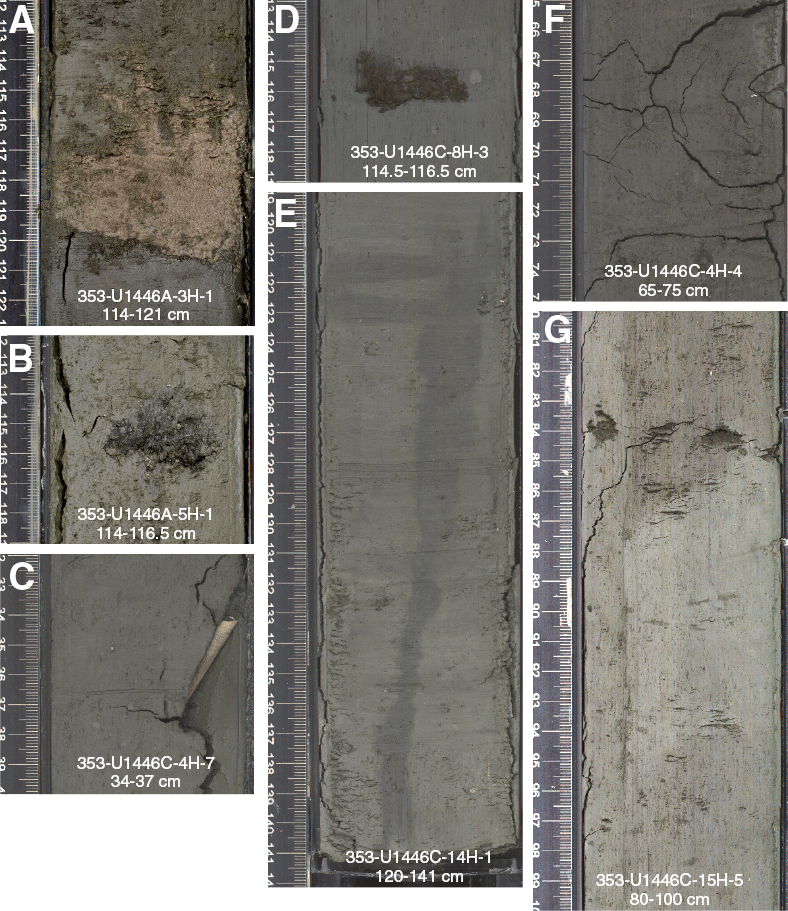Featured Image: Line-scan image of sediment core from the Bay of Bengal. Image from the International Ocean Discovery Program. A. Volcanic ash associated with the Toba eruption. B. Pyrite-, foraminifer-, and shell fragment–rich sandy patch in foraminifer-rich clay with biosilica. C. Scaphopod in nannofossil-rich clay with foraminifers. D. Wood fragments in clay. E. Large dark gray burrow filled with the overlying sediment. F. Core disturbance (cracks) due to gas release when core liner was drilled on the catwalk. G. Minor core disturbance due to mud and water flow-in along the edges of the liner (~1 cm thickness).
Paper: Increased interglacial atmospheric CO2 levels followed the mid-Pleistocene Transition
Authors: Masanobu Yamamoto, Steven C. Clemens, Osamu Seki, Yuko Tsuchiya, Yongsong Huang, Ryouta O’ishi, Ayako Abe-Ouchi
Mention of the ice age may conjure up images of giant mastodons, ferocious saber-tooth tigers, or of a prehistoric squirrel trying so desperately to secure his acorn—all taking place on the vast amount of ice that covered portions of the globe. We know that periods of ice cover followed by stretches of warm weather was a standard pattern in our Earth’s history*, but there was something special about the last ice age (during the Pleistocene) and how long it hung around.
We know that gasses like carbon dioxide warm the earth and melt terrestrial ice. However, new research suggests this may not have been the case during our last ice age. About halfway through the Pleistocene, a fundamental shift in Earth systems occurred, called the Mid-Pleistocene Transition (MPT). This transition led to the increase in duration of ice cover from 40,000 years to over 100,000 years (sorry Scrat, you’re going to need more than one acorn to feed yourself over this ice age). Masanobu Yamamoto and colleagues found that while carbon dioxide levels were high, terrestrial ice sheets continued to grow. The exact process of this phenomena is unknown, but research suggests it’s paired with a decrease in carbon dioxide capture in the deep Pacific.
Typically, Earth hosts a predictable relationship between carbon dioxide in the atmosphere and terrestrial ice cover. Carbon dioxide is a greenhouse gas capable of warming the Earth significantly by trapping the sun’s heat, and this warming drives a decrease in terrestrial ice cover. Warming of our planet also affects how strong the ocean currents are by increasing or decreasing differences in temperature (imagine opening a freezer in the summertime: the cold air spills out and seems to blow over your feet and as the two different temperatures mix). However, the MTP did not follow this recipe and instead the North American ice sheet expanded under relatively high carbon dioxide concentrations. What could drive such a counterintuitive pattern? Yamamoto and colleagues suggest that this phenomenon was initiated by the deep ocean. Specifically, the ocean decreased movement of atmospheric carbon to the abyss, storing it away from the atmosphere where it acts as a greenhouse gas.
To study paleoclimate, scientists access deep sediment cores from the ocean. Sediment can preserve a surprisingly clear record of climatic events and preserves them for us to observe today. Several cores from the Bay of Bengal—off the coast of Eastern India—served to help Yamamoto and colleagues identify the decrease of carbon dioxide storage in the deep ocean and the contradictory buildup of terrestrial ice during the MPT by measuring light carbon atoms in prehistoric plants. Previous research has clearly illustrated past climates by using ice cores, tree rings, corals, microscopic ocean critters called foraminifera (or forams for short), pollen fossils, and many other geologic records, but none of these measurements captured the MPT in great detail. This new technique using decomposed plant leaves buried in ocean sediments was compared to previous reconstruction methods including ice cores and forams. By overlaying these different techniques, Yamamoto and colleagues were able to see how well these methods agree on past climate events and use each method to fill in any blanks left by the other methods. Together, these reconstructions created a high-resolution dataset that allows scientists to see that atmospheric carbon dioxide levels during the MPT increased, despite massive ice sheet growth.
Since using plant leaves is a relatively new method in paleoclimatology, the authors conducted rigorous testing to see how precipitation, temperature, and atmospheric composition may have affected these ancient plants and changed the way they recorded climate events. For example, if several years were significantly wetter or dryer than expected for the region, the plant leaves may reflect a different pattern when compared to ice core and foram reconstruction. The scientists concluded that despite these weather perturbations that affect vegetation, this new method is reliable in predicting past climates in approximately 1,000-year chunks.
As our climate continues to change in the present, it becomes even more important to understand how Earth systems functioned in the past. Yamamoto and colleagues uncovered previously unknown mechanisms in the relationships between atmospheric carbon dioxide, terrestrial ice cover, and ocean currents. While the specifics of this relationship is still unknown, this discovery requires attention as it may impact our response to our climate in the present and future.
*While these are well understood Earth patterns, it’s important to note that our current time period, the Anthropocene, is experiencing warming that is almost exclusively human caused. For more information please visit the IPCC Sixth Assessment Report.
“Greenhouse gasses, ice cover, and the deep ocean shape Earth’s paleoclimate in unexpected ways” by Jessica Buser-Young is licensed under a Creative Commons Attribution-ShareAlike 4.0 International License.

